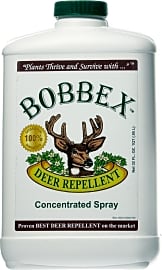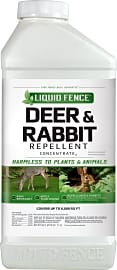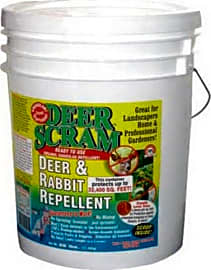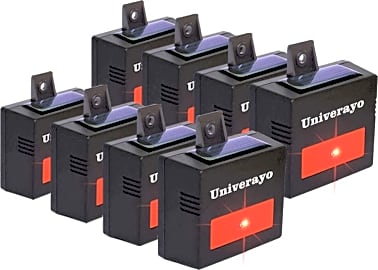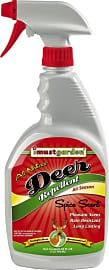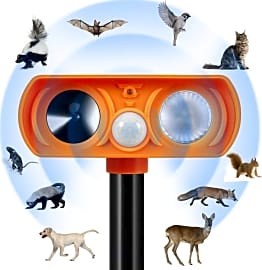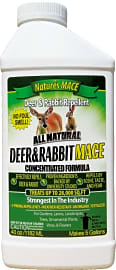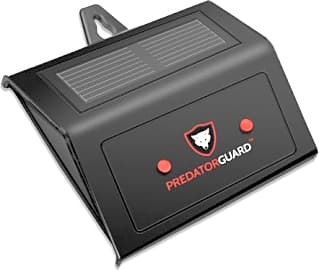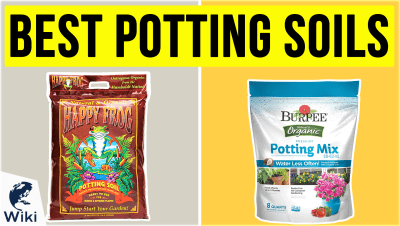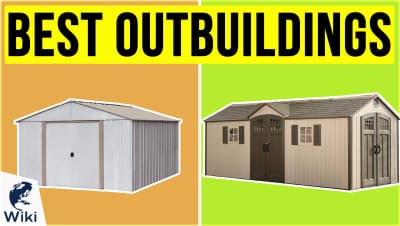The 10 Best Deer Repellents

This wiki has been updated 39 times since it was first published in July of 2015. If you're having trouble keeping the local wildlife out of your vegetable gardens and flower beds, then a high-quality deer repellent might be your best bet. The options on this list use various methods to deter animals from grazing on your property without harming them, including sound waves, lights, sprays, and granules. Many are safe to use around children or pets. When users buy our independently chosen editorial picks, we may earn commissions to help fund the Wiki.
Editor's Notes
October 21, 2020:
For this update, we've added two deterrents that don't require the application of any substances. However, you will have to install them. The compact, portable Zomma Ultrasonic is a breeze to install - just stick in the ground - which also makes it a good choice for camping trips and outings to the park. It uses sound waves to keep critters away, while the Hoont Cobra shoots water at any intruders. Both are motion-activated.
We've removed the Messina Wildlife Deer Stopper because its reviews were no longer on par with the other items on our list. We also removed the Epic Deer Scram Professional, which was an alternate version of the Enviro Pro 1025.
We've also updated several items, including La Torre's Deer Out, Bobbex B550100, and the Univerayo Solar Predator Control 8 Pack. Finally, we've added a new Special Honor: a real-life repellant with bonus features that include wagging, cuddling, and slobbering.
April 24, 2019:
Keeping deer away from your flowers and vegetable gardens may feel like an unwinnable struggle, but before throwing in the towel for good, try one of these repellents. Many users find scent-based methods to be the most effective. Options like Epic Deer Scram Professional and Enviro Pro 1025 are made from animal byproducts, such as meat, blood, and bone meal, which makes deer think that a carcass is nearby and also predators. Other scent-based formulas make use of eggs, which produces a similar effect as rotting meat smells, or garlic, spices, and other strong fragrances that deer find unpleasant. Some of these options on our list include I Must Garden Spice Scent, Liquid Fence Deer and Rabbit, La Torre's Deer Out, and Bobbex B550100. Despite the majority of the items on our list being all-natural and safe to use on edible plants or around kids and pets, some users may want to forgo scent-based methods all together as they fear applying any product around their home. For those readers, we have included the Univerayo Solar Predator Control 8 Pack and the Predator Guard, which rely on a simple, solar-powered flashing red light to scare away foraging animals. Unlike other products, these don't need to be reapplied periodically, but their effectiveness can be questionable.
Special Honors
Adopt a Pet For a deer deterrent that loves you back, consider adopting a dog from one of 17,000 shelters and rescue centers. The mere presence of a predator (or a perceived predator) in your yard will keep other animals from wandering through. Adopting a dog isn't a decision to be taken lightly, but it's something to consider if you have room in your life for a furry friend. adoptapet.com
Keeping Deer At Bay: Choosing A Deer Repellent
These sprinklers can be rather expensive, though, and require a water source and occasional recalibration and maintenance.
Once a deer has taken an interest in your property, it can be an immense hassle to get them to vacate the area again. The problem is compounded when the deer arrive in numbers, and is further exacerbated if your property is rich in edible foods, flowering plants, and other flora you value for its looks or that you planned to eat yourself. A deer is easily frightened away by the sudden appearance of a person, but will return time and time again to feed on your flowers, foods, and shrubs -- not to mention the garbage you leave out at night -- if you don't give them a convincing reason to leave and not return. The solution to an unwanted ungulate guest is to use the right deer repellent.
There are two approaches to repelling deer and other pests: use a scent-based repellent the animal will find so odious they will not be able to stand the stench and will look for other foraging grounds, or use a surprise based repellent device that frightens the deer away every time they come near, soon teaching the animals that your property is not a safe area.
If you choose to go with the scent repellent approach, choosing the right formula means assessing the habits of the deer you're trying to repel. If the animals only go after a small bed of flowers or edible plants, for example, consider one of the highly concentrated and long-lasting formulas and apply it as a barrier to the limited area at issue. These powerful liquid formulas usually last weeks if not months, firmly establishing the treated area as unapproachable to deer (and rabbits and squirrels and other mammals at that). On the other hand, most concentrated liquid repellents are quite pricey.
Pellet style scent repellents are cheaper than liquid repellents and are perfect for spreading liberally around a yard or large planted area where deer are nibbling. You can distribute large amounts of these pellets across your property and repeat the process as needed until the deer no longer return. These pellet repellents require a bit more hands-on effort, but are pleasantly affordable.
The other approach to keeping deer at bay is to use a mechanical device that scares them off. Some such devices use ultrasonic sound waves the human ear can't detect but that animals can't stand. The benefit is zero effect on yourself or your property, but know that other animals, like your dog, may be affected. Most such devices also use flashing lights which make them more effective at scaring deer, but which can also be an annoyance to humans. Motion detecting sprinklers are another great tool in your "fight" against deer, as no buck or doe who is suddenly blasted with water will soon forget the fearful experience. These sprinklers can be rather expensive, though, and require a water source and occasional recalibration and maintenance.
How To Make Your Property Less Deer Friendly
The best way to prevent deer from ruining your yard or garden is to prevent them from ever entering it. Erecting a fence too high for a nimble deer to jump means installing a barrier as much as ten feet high, which may be prohibitive for some properties based on ordinances, aesthetics, logistics, or cost. Large hedges can stand in for a fence, but they will take years to reach sufficient height and thickness to reliably prevent deer.
Basic yard and garden maintenance does much to dissuade deer from coming near. Keep the grass trimmed short and pick vegetables and fruits once they ripen. Also keep plants, shrubs, and trees properly trimmed and clear out underbrush, thereby reducing the number of spots in which a deer can hide or even bed down.
If you want to plant flowers or edibles without the protection of a fence, help to create a virtual barrier around the plants by also growing things like garlic, mint, and onions -- these are plants you can harvest and enjoy but that are unpleasant to the deer's nose and which can mask the scent of more alluring options.
American Deer: A Survival Story
While it's impossible to know exact numbers, experts estimate that the total population of deer in the region today known as the United States, just prior to their first contact with Europeans in the late 15th Century numbered between 30 million and 40 million animals. As of an estimate assembled in 2014, there are an estimated 32.2 million deer -- including white-tailed deer, blacktail, and mule deer -- in the country today. Those similar figures suggest an uncanny population stability at first glance, but in fact obscure a dramatic story of decline and resurgence.
Fortunately, this threat was recognized by the United States government, which enacted the Lacey Act in 1900.
With the dramatic increase of deer hunting brought on by new settlement and then the subsequent rapid population expansion of the centuries intervening between the 15th and 21st, American deer population in fact plummeted precipitously. By the turn of the 20th Century, there were only some 500,000 deer left in America. The species faced a genuine threat to its continued survival. Fortunately, this threat was recognized by the United States government, which enacted the Lacey Act in 1900. It was the country's first federal wildlife law and it restricted interstate transport and sales of venison and hides (among other things), thereby slowing the unbridled harvest of deer. And it worked.
Soon supported by laws and new conservation departments that cropped up in dozens of states in the early 1900s, deer populations soon rebounded. The human population shift toward living cities that began largely as a result of the Great Depression eradicating countless rural jobs was yet another boon to deer populations. Suddenly the deer had newly uninhabited space in former farmland and pastures in which to roam, graze, and settle.
Above anything else, it is the deer's remarkable adaptability that has helped the species recover and flourish from the brink of collapse. Deer can live an entirely wild life deep in untouched forests, or they can survive in the suburbs and even in the cities mankind creates where once wildlife ruled. Today, even with as many as ten million deer hunters annually taking to the forests and hoping for a kill or three, deer populations remain robust and stable.


